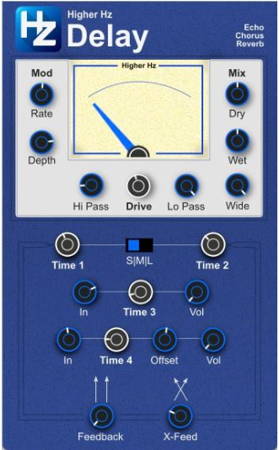HZ Delay WiN MAC FREE
FREE | May 27th 2022 | 4.8 MB / 2.6 MB
HZ Delay is a character effect which means that it doesn’t do all things equally. Matter of fact it deliberately does some things oddly or not at all to allow it to have the sort of character so sought after in older analog gear.
The sorts of effects or outcomes HZ Delay will help you to achieve are:
Saturation
Chorus – simple and BBD
Echo – simple and multi-tap
Reverb – simple early reflections
The idea is that commonly you will be balancing some or all of the above as you use HZ Delay to add depth & sparkle to any (or all) of the sounds in your mix. Maybe not the Masters but where there is a will, there is a way.
Signal flow
It is worth understanding the signal flow as not everything moves in a straight line all the time.
Signal arrives in the unit via a drive that will add soft distortion to the whole signal. This includes the dry signal as well. This means that HZ Delay can actually be used as a saturation unit with no other features. The reason that it is done this way is that when the driven signal is mixed with the driven+effected signal, the results are far more interesting.
Signal is on a Bus that initially is sent to the Delay 1+2 which is a stereo pair hard-panned left & right. These delays can be set to very short, short, and long ranges. The first setting is for chorus, the second for reverb, third for longer echoes.
Delay 3 can be fed a mix of the initial driven signal and the Delay 1+2 signal. Delay 3 is always set to a full time range which means that it can be longer than Delay 4+4I.
Delay 4+4i can also be fed a mix of the initial driven signal and Delay 3. The overall time is set to a short range. The 4i version is generated from the offset value which moves the right time shorter or longer than the initial value for a stereo spread.
Each of the delay sections sends its signal to the Wet Output and can also be fed back into the first bus using standard left & right or the left & right can be reversed for a more complex signal. Take care with feedback as larger values can very easily create a feedback loop that will howl until one or both feedback knobs are lowered.
Tone can be adjusted with a 6db high and low pass filter at the first audio bus. This means that with feedback, tone adjustments are cumulative.
There is a modulation system that is relatively simple with Delay 1+2 but more complex for the other delay lines.
Please REPORT in Comment Broken Links

